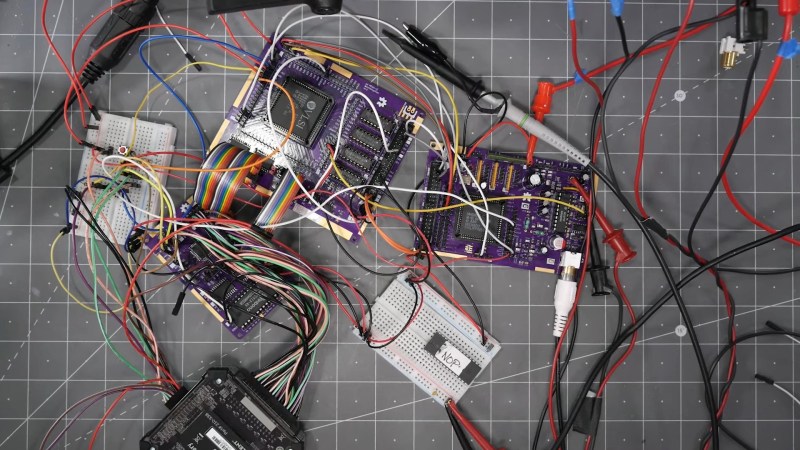The Apple II is one of the most iconic microcomputers, and [James Lewis] decided to use the Mega-II “Apple IIe on a chip” from an Apple IIgs to build a tiny Apple IIe.
While there was an Apple II compatibility card using the related Gemini chip, it was initially unclear whether the Mega-II could even work outside of an Apple IIgs given the lack of documentation for either Apple II SOC. [Lewis] did finally get the Mega-II to boot after a great deal of effort in debugging and design. The system is built with three boards: the Mega-II and RAM board, a CPU board with a 65C02, and a video out board.
To simplify routing, the boards are all four layer PCBs. Unfortunately, the chips needed to make this system, especially the Mega-II, aren’t available on their own and must be harvested from an existing IIgs. [Lewis] took care to make sure any desoldering or other part removal was done in a way that it could be reversed. If you want to see all the nitty gritty details, check out his GitHub for the project.
If you want another 6502-based computer in a tiny package, why not try this one built on Perf+ boards?
















Be interesting if one took a die picture of the mega-II.
It’s been done. Enjoy.
https://archive.org/details/344S0047AApple8652Die280nmpp_201806
Well, there’s a chip that needs the full Ken Shirriff treatment!
Honestly, it’s not that terribly exciting a chip. It’s a very basic series of counters and multiplexers with a character generator ROM, designed to satisfy refresh timing for late 1970s DRAM. Nothing fancy, zero acceleration, no sprites, no palettes, no character RAM, but double hires is nice. Even the VGC used here as a lobotomized appendage has far greater capabilities including palettes and better resolution. If you want to know more about the circuitry, I would highly recommend “The Apple ][ Circuit Description” by Winston D. Gayler which is available at the Internet Archive and other places and well worth your time. The //e designs are also floating about, including the MMU and IOU chips. The design is very basic and easy to recreate within any modest FPGA or larger CPLD. Speaking as a ][, //e, and //gs hardware and software developer this was a dead end for many reasons and a huge drain of resources, but Apple was moving on to 32 bit architectures and it was time to kill off the 8 bit stuff by giving users one last and intentionally underperforming machine to encourage migration.
Great comment.
After working out most of its operation, I can confirm the Mega-II is an integration of the IIe chipset, 80-col card, and IIgs specific capabilities.
Gayler’s book was invaluable in understanding many of the Mega-II’s operations even though it was written for the II/II+. That at the IIe hardware reference manual became my go-to resources.
Interestingly, the Mega-II does not refresh its DRAM the same way the IIe does, plus a handful of other things. Which is one reason I would like to re-create it in an FPGA since it is not an identical copy of the IIe chipset–but at least it is a starting point.
This video is from almost a year ago. Since then, I now have the Mega-II booting and running all the IIe (and before) software I have tried. It really does appear the Mega-II was a fully functional IIe.
It is also very clear to me just how little the IIgs used it. None of its address decoding is used. The video circuit only used for 8-bit apple modes. It’s really quite overkill to act as an I/O controller. But it clearly gave the IIgs I/O backward-compatibility without having to develop an new chip, since the Mega-II was already done.
Speaking of the lobotomized VGC. I feel that I got very, very lucky with its turn-on state. It operates without any configuration. For a while, I thought there was a problem because the first column of 80-col mode was missing. Then later, I realized the right column of 40-col mode was missing.
It wasn’t until I looked at the SERVID signal and did some testing that I confirmed the Mega-II was outputting pixel data but the VGC wasn’t displaying it. Then, one day it, it hit me. The VGC was displaying a black border around the “screen!”
Rev 3, the final version, I replaced the VGC with an RP2040 that outputs VGA. And it looks quite good!
Thanks for sharing the project! Keep your eyes open. Part II of the video is in the works.
Spoiler: The Mega IIe is now a fully compatible Apple IIe computer.
Cool project. Looking forward to part II.
Don’t you mean “part ][“?
B^)
Maybe part //